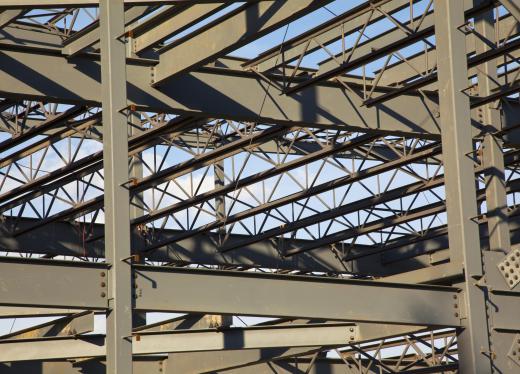Manganese steel, also known as Hadfield steel and mangalloy, is an alloy of steel and manganese. Most steel has a small bit — around 0.15 percent to 0.8 percent — of manganese added to it, but manganese steel contains around 11 percent to 15 percent manganese. Adding manganese to a steel alloy gives it many unique properties, such as resistance to magnetism, abrasion resistance, extreme durability and better surface hardness without an increase in brittleness. While its high durability is a boon in many industries, it makes this metal very hard to machine and drill into, requiring a diamond-tipped drill or other powerful drilling method. Most all manganese made and used is added to steel alloys.
Steel is an alloy of iron and carbon, and it usually has trace amounts of other metals, such as manganese. The usual amount of manganese is slight and helps steel become tougher so it can be used to make tools or in construction. Manganese steel adds a substantial amount of manganese to the mixture, around 11 percent to 15 percent, but some metallurgists add up to 25 percent manganese.

Manganese, when used in such a high amount, lends many special properties to steel. While manganese itself is magnetic, this magnetic property is lost when manganese is combined with steel, leaving the metal completely resistant to magnetism. The durability and abrasion resistance also goes up dramatically, along with hardness and impact strength. While most alloys that help hardness increase brittleness, the manganese additive keeps manganese steel from experiencing this brittleness problem, allowing it to pulverize many materials on impact.
While durability and hardness are usually good qualities in a sturdy metal, especially one used for construction, it is these two qualities that keep manganese steel from being used more frequently. This steel alloy is so tough that drilling and cutting it to form new parts is nearly impossible. Even diamond-tipped drills have difficulty drilling into this steel, and heating it will make this alloy stronger than carbon steel. Plasma cutting is one of the few effective ways to cut manganese steel.
The material manganese is found in nature, but more often is created by heating pyrolusite with charcoal. Manganese has many uses, but most manganese is made to be added to steel, either for regular steel alloys or for manganese steel. About 90 percent of all manganese is made for this purpose, while the rest is used to boost octane ratings in gas or to alloy with other metals.
